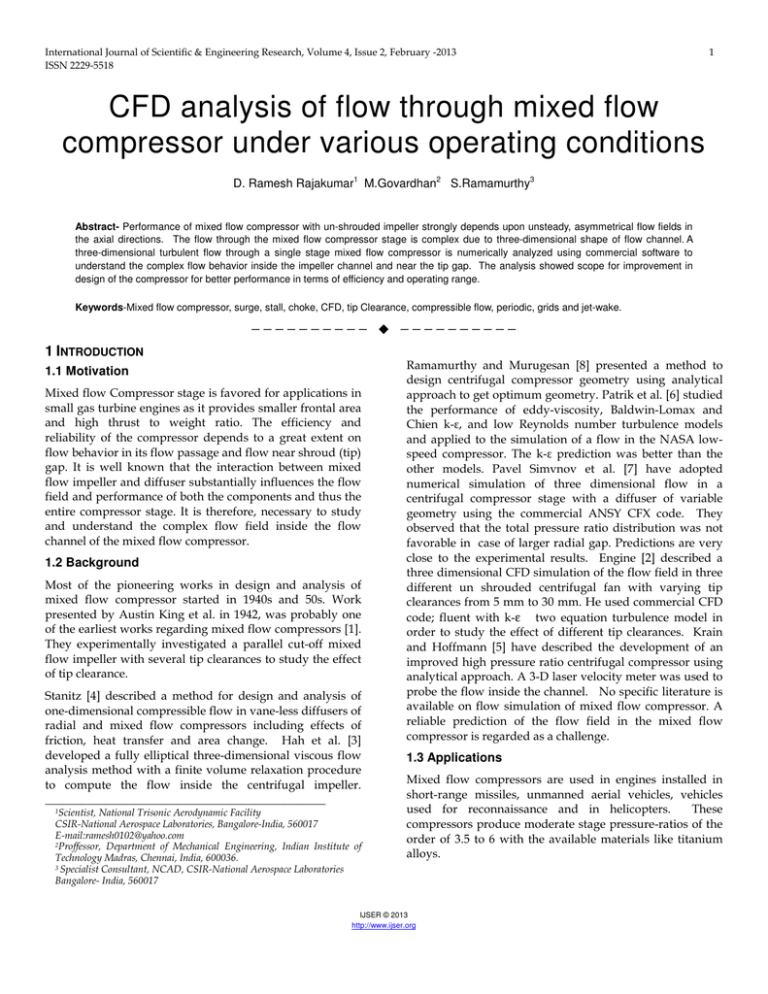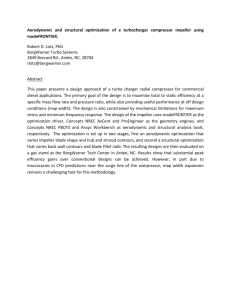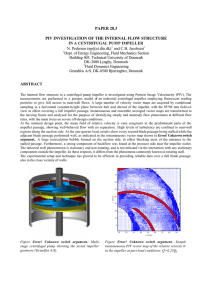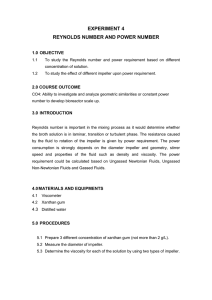CFD analysis of flow through mixed flow compressor under various
advertisement

International Journal of Scientific & Engineering Research, Volume 4, Issue 2, February -2013 ISSN 2229-5518 1 CFD analysis of flow through mixed flow compressor under various operating conditions D. Ramesh Rajakumar1 M.Govardhan2 S.Ramamurthy3 Abstract- Performance of mixed flow compressor with un-shrouded impeller strongly depends upon unsteady, asymmetrical flow fields in the axial directions. The flow through the mixed flow compressor stage is complex due to three-dimensional shape of flow channel. A three-dimensional turbulent flow through a single stage mixed flow compressor is numerically analyzed using commercial software to understand the complex flow behavior inside the impeller channel and near the tip gap. The analysis showed scope for improvement in design of the compressor for better performance in terms of efficiency and operating range. Keywords-Mixed flow compressor, surge, stall, choke, CFD, tip Clearance, compressible flow, periodic, grids and jet-wake. —————————— —————————— 1 INTRODUCTION 1.1 Motivation Mixed flow Compressor stage is favored for applications in small gas turbine engines as it provides smaller frontal area and high thrust to weight ratio. The efficiency and reliability of the compressor depends to a great extent on flow behavior in its flow passage and flow near shroud (tip) gap. It is well known that the interaction between mixed flow impeller and diffuser substantially influences the flow field and performance of both the components and thus the entire compressor stage. It is therefore, necessary to study and understand the complex flow field inside the flow channel of the mixed flow compressor. 1.2 Background Most of the pioneering works in design and analysis of mixed flow compressor started in 1940s and 50s. Work presented by Austin King et al. in 1942, was probably one of the earliest works regarding mixed flow compressors [1]. They experimentally investigated a parallel cut-off mixed flow impeller with several tip clearances to study the effect of tip clearance. Stanitz [4] described a method for design and analysis of one-dimensional compressible flow in vane-less diffusers of radial and mixed flow compressors including effects of friction, heat transfer and area change. Hah et al. [3] developed a fully elliptical three-dimensional viscous flow analysis method with a finite volume relaxation procedure to compute the flow inside the centrifugal impeller. _______________________________________________ 1Scientist, National Trisonic Aerodynamic Facility CSIR-National Aerospace Laboratories, Bangalore-India, 560017 E-mail:ramesh0102@yahoo.com 2Proffessor, Department of Mechanical Engineering, Indian Institute of Technology Madras, Chennai, India, 600036. 3 Specialist Consultant, NCAD, CSIR-National Aerospace Laboratories Bangalore- India, 560017 Ramamurthy and Murugesan [8] presented a method to design centrifugal compressor geometry using analytical approach to get optimum geometry. Patrik et al. [6] studied the performance of eddy-viscosity, Baldwin-Lomax and Chien k-ε, and low Reynolds number turbulence models and applied to the simulation of a flow in the NASA lowspeed compressor. The k-ε prediction was better than the other models. Pavel Simvnov et al. [7] have adopted numerical simulation of three dimensional flow in a centrifugal compressor stage with a diffuser of variable geometry using the commercial ANSY CFX code. They observed that the total pressure ratio distribution was not favorable in case of larger radial gap. Predictions are very close to the experimental results. Engine [2] described a three dimensional CFD simulation of the flow field in three different un shrouded centrifugal fan with varying tip clearances from 5 mm to 30 mm. He used commercial CFD code; fluent with k-ε two equation turbulence model in order to study the effect of different tip clearances. Krain and Hoffmann [5] have described the development of an improved high pressure ratio centrifugal compressor using analytical approach. A 3-D laser velocity meter was used to probe the flow inside the channel. No specific literature is available on flow simulation of mixed flow compressor. A reliable prediction of the flow field in the mixed flow compressor is regarded as a challenge. 1.3 Applications Mixed flow compressors are used in engines installed in short-range missiles, unmanned aerial vehicles, vehicles used for reconnaissance and in helicopters. These compressors produce moderate stage pressure-ratios of the order of 3.5 to 6 with the available materials like titanium alloys. IJSER © 2013 http://www.ijser.org International Journal of Scientific & Engineering Research, Volume 4, Issue 2, February -2013 ISSN 2229-5518 2 OBJECTIVES 3 GEOMETRIC MODELING AND MESHING In this work, computational investigations are carried out to get the stage performance map with tip clearance of 0.5 mm for different operating speeds and mass flow rates covering the complete operating range from choke to surge. The computational simulations are done at five different speeds. Mixed flow impeller was designed for 2.72 kg/s and static to total pressure ratio of 3.8 with design speed of 39836 rpm. The complex flow inside the impeller channel is studied at different flow conditions. Specifications of the mixed flow compressor are shown in Table 1. 3.1 Modeling 2 Figure-1 shows the CAD model of compressor stage designed and generated in solid works CAD package. As the domain is axi-symmetric, a single channel consisting of one main blade and one splitter blade is considered for flow analysis. A vane-less space is provided downstream of the impeller is also considered. TABLE 1 Specifications of mixed flow impeller Impeller inlet parameter Value d1it Impeller inlet tip diameter d1ih Impeller inlet hub diameter N Impeller rotational speed (m) (m) (RPM) 0.156 0.0625 39836 Hub–to–tip diameter ratio d1ih d1it 0.40 Relative blade angle at tip β1it 61.8 Relative blade angle at hub (deg) β1ih (deg) Impeller exit parameter Impeller exit tip diameter d2it (m) d 2ih Impeller exit hub diameter (m) Impeller exit blade height b2i (m) Relative blade angle at tip β 2itI Relative blade angle at hub Absolute flow angle α2it β 2ihI (deg) 0.253 0.239 0.0141 (deg) (deg) Fig.1. CAD model of mixed flow impeller 36.7 58.5 46.8 70 Impeller domain is generated using Gambit turbo tool preprocessor. Turbo tool was used for constant tip clearance configuration of 0.5 mm. The flow domain is divided into multiple volumes to form cube like structure so as to fit hexahedral element. Meshing was carried out using Gambit preprocessor. Hexahedral mesh elements were used in all volumes except near the clearance region over the main blade and splitter blade. Grid independence study was done for 62349 and 127150 elements with zero tip clearance and result is shown in Fig.2. The result shows that number of elements beyond one lakh has no influence on the performance of compressors. However, higher elements are considered for analysis due to zero skewed elements. 3.2 computational methodology Impeller main blades 11 Impeller splitter blades 11 For the present work, computations were performed using commercial code namely Fluent. A 3D viscous flow through impeller was analyzed. Segregated solver is used. The numerical fluxes are estimated with first order upwind scheme. IJSER © 2013 http://www.ijser.org 3 International Journal of Scientific & Engineering Research, Volume 4, Issue 2, February -2013 ISSN 2229-5518 magnitude from its initial value and the integrated residuals of all the variables were reduced by six orders of magnitude, the solution was considered as converged. The mass flow summary, the residual history of the variables and the monitor point values were used to judge the convergence behavior of the theoretical analyzed results. The mass imbalance was checked after the solution was converged. In all the cases the observed imbalance in mass flow rate was as low as 0.001%. 3.3 Boundary Conditions Figure 4 shows the flow domain along with boundary conditions assigned in the present analysis. Inlet boundary conditions used were total pressure, total temperature, and absolute flow angle. Fig.2. Grid independence study For the present analysis there are 1080292 elements are used. The mesh geometry is shown in Fig.3. Table 2, below gives the elements in different regions. TABLE 2 Number of elements at domain Fluid volume Surface mesh Solid mesh size Number of cells Shroud clearance Pave Hex/cooper 1 63362 impeller pave Tet/hybrid 3 1016930 total 1080292 The distribution of these quantities was assumed constant throughout inlet boundary and hence single value was given. At exit, static pressure (sometimes termed as backpressure) was specified. Periodic boundary conditions were imposed on side faces of tip clearance, upstream and downstream of the impeller blade. The shroud casing was considered stationary. Hub surface and blades of impeller were specified as rotating frame. Fig.4. Flow domain and BCS 4.0 RESULTS AND DISCUSSIONS Fig.3. Typical mesh of the computational domain The continuity equation, which governs mass conservation, is used to determine the pressure field in the pressurebased method. Turbulence is modeled using standard k-ε model. When the integrated residual of the pressure correction equation was reduced by four orders of 4.1 Performance characteristics The performance of the compressor estimated for various operating speeds with 0.5mm tip clearance from the CFD code is shown in Fig.5. The performance of the impeller was obtained for five speeds, which includes 60%, 75%, 90%, 100% and 105% of the design speed. At each speed the complete impeller operating range (choke to surge) was obtained. The total to total pressure ratio is plotted against mass flow parameter for different operating speeds. It is observed from this figure that at design speed compressor shows choke mass flow rate of 3.29 kg/s whereas the IJSER © 2013 http://www.ijser.org International Journal of Scientific & Engineering Research, Volume 4, Issue 2, February -2013 ISSN 2229-5518 surging mass flow rate is around 2.39 kg/s. The impeller design mass flow rate at the design speed is 2.73 kg/sec. Hence compressor at design speed has roughly about 37% surge margin. The estimated pressure ratio (4.50) is slightly lower than design pressure ratio (4.55) due to the inaccuracy in the loss models used in the design. The performance at speed higher than design speed shows a maximum mass flow rate that can be allowed through the impeller is 2% of design mass flow rate. The isentropic efficiency of the impeller was estimated from the impeller total to total pressure ratio and total to total temperature ratio for 0.5mm tip clearance at different speeds. The variation of impeller isentropic efficiency for different speeds that were considered in Fig. 5 is shown in Fig. 6. The peak efficiency of the impeller for various speeds is around 91%, which corresponds to flow having zero incidence at impeller inlet. The impeller design efficiency is 93.8%. On either side of the peak efficiency point the impeller efficiency drops. The sharp drop in efficiency is noticed towards choking side. The lowest efficiency value which corresponds to unstable operating point at different speeds increases with increase in speed. 4 This compressor was tested in closed circuit compressor test rig with vane-less configuration up to 32000 rpm. Vane less diffuser outlet static pressure and impeller inlet static pressure were measured for different mass flow conditions The measured stage pressures are plotted against measured mass flow for five different speeds. Through Fluent code, for these speeds and inlet flow conditions the outlet pressure and mass flow through the compressor are estimated. The estimated pressure ratio from CFD is plotted against mass flow rate and compared with experimental values for different speeds. The performance graph obtained is shown in Fig.7. Fig.7.Comparison of performance It is observed from this figure that the agreement between CFD and experimental results is good at all speeds. Estimated mass flow is 7.8 % (average) lower than the measured mass flow due to blockage is not considered in the design . This is attributed to small error in mass flow measurement in experimental investigations. . Fig.5. Impeller pressure ratio 4.2 Blade loading To study the variation of static pressure on the blade suction and pressure surfaces, different operating point at 29000 rpm is selected and these points are indicated in figure 9 as A, B, C, D, E and F. These operating points were selected such that they are close to surge, design and choke conditions. These points on the graph are represented as A, C and F. At these selected points the variation of static pressure along the blade surface length is shown in Figs. 10a, 10b and 10c. The local static pressure is normalized with inlet total pressure. The local surface distance is normalized with total surface distance. In each figure, the static pressure variation at three different locations namely, hub, mean and tip section are shown. Fig.6. Impeller efficiency IJSER © 2013 http://www.ijser.org International Journal of Scientific & Engineering Research, Volume 4, Issue 2, February -2013 ISSN 2229-5518 5 Fig.9. Operating points for flow studies Fig.10c. Blade static pressure variation At the surge point there is drop in blade loading. At each station, the area under pressure distribution curve is higher at the tip section compared to hub section. This behavior is not seen at the surge flow rate. Hence the tip section is highly loaded as the work done is highest at tip section. It is also observed that the static pressure across the blade length increases uniformly from inlet to outlet indicating continuous pressure rise. This behavior is observed at all locations except at choke mass flow. 4.3 Flow angle variations Fig.10a.Blad static pressure variation It is observed that a cross over occurs in static pressure distribution curves at choke flow rate, indicating reduction in blade loading. As the mass flow rate is reduced, the pressure distribution curve improves and blade loading increases. Fig.10b. Blade static pressure variation The flow angles at impeller exit was estimated from CFD results at 29000 rpm for three operating points A, C and F as indicated in Fig.9. The meridional plane considered is slightly away from the impeller exit. These angles being calculated from the local values of velocities namely U, W and C. The local position of each velocity vector at impeller exit is being captured by local co-ordinates. The relative flow angle and absolute flow angle variation with respect to normalized arc length at three span wise location at impeller exit are shown in Figs. 11a-11d. The spanwise locations being taken one at mid wall (50% of blade height) and one at very close to the shroud wall (95% of blade height). The variation of flow angles at shroud wall represents the tip clearance effects. The relative flow angle variation at impeller exit at 95% of blade height is shown in Fig.11a.The locations of pressure and suction surface of the adjacent blades are indicated as PS and SS in this Figure. It is observed that very close to the blade locations the relative flow angle drops at operating points A and C where as in the blade passage the flow angles are higher than the blade angle. The design blade outlet angle at shroud is 58.5 deg. At operating point A, the flow angle is higher than blade angle by about 8 degrees and at design point the flow angle is slightly higher than the blade angle. The difference in the flow angle and the blade angle represents the slip. It shows the slip increases from operating point C to A. At the operating point it is observed that the flow angle is lower than the IJSER © 2013 http://www.ijser.org 6 International Journal of Scientific & Engineering Research, Volume 4, Issue 2, February -2013 ISSN 2229-5518 blade angle by about 8 deg. However it is seen from Fig.11b, the absolute flow angle decreases from surge point to choke point. This is because as the operating points moves from A to F the mass flow rate increases and the pressure ratio drops. The reduction in pressure ratio indicate the drop in work done by the impeller, hence the tangential component of absolute velocity at impeller exit reduces. As the mass flow increases, the meridional component of absolute velocity increases. The combined effect is reduction in absolute flow angle at operating point F. The variation in absolute flow angle is very predominant as the mass flow rate is increased. This will have a large effect on the diffuser producing large negative incidence. The typical change in flow angle at the blade locations will have large influence on the diffuser flow as the number of diffuser blades are fraction of number of impeller blades. The flow angle variation very close to the blades is very large due to the tip leakage flows, which is not observed at 50 % of blade height. Figures 11c-11d represents flow angle variation at impeller exit at 50% of the blade height for same operating points considered in the previous case. Here the relative flow angle variation with respect to operating point shows the flow angle increases with decrease in mass flow rate. But the average value of flow angle is higher than the blade angle at operating points A and C. The design blade angle at 50% of blade height is 52.6 deg. The absolute flow angles remain constant over the blade pitch for a given operating point except close to the blade locations. The variation in the flow angle near the blade locations are smaller than the variation at 95% of the blade height, indicating the influence of tip clearance flow is marginally felt. Fig. 11c. Relative flow angle at 50% blade height for outlet of impeller Fig. 11a.Relative flow angle at 95% blade height for outlet of impeller Fig.11d. Absolute flow angle at 50% blade height for impeller outlet Fig. 11b. Absolute flow angle at 95% blade height for impeller outlet IJSER © 2013 http://www.ijser.org International Journal of Scientific & Engineering Research, Volume 4, Issue 2, February -2013 ISSN 2229-5518 7 4.5 Relative Mach number and velocity variation in flow channel To study the flow behavior inside the impeller channel, different meridional planes namely Inlet, P1, P2, P3, P4, P5, P6 and outlet are considered. Among these planes, four planes namely P1, P4, P6 and impeller outlet planes are used to represent the variations of relative velocities for clarity. The representation of the planes is shown in Figure 12a and the relative Mach number plot for different flow conditions at the different planes is shown in Figure 12b. It is observed from Fig.12b that the relative Mach number at impeller outlet is uniform and increase from surge to choke flow conditions. At inlet plane, the relative Mach Number for each flow condition increases from hub to tip as the blade speed increases and inlet absolute velocity is axial and uniform. Within the blade channel, at plane P4 and P6, the relative velocity is not uniform. Fig.13a.Relative velocity variation at operating point -C In this figure relative velocity is being plotted over two blade pitch so that at any location within the blade channel one main blade and one splitter blade are present. In each figure P and S represents pressure and suction surfaces of the adjacent blades and hub and shroud locations are also marked. Fig. 12a. Meridional planes Fig.13b.Relative velocity variation at operating point –A It is observed for the impeller outlet plane the relative velocity decreases from suction surface to pressure surface at all meridional locations except at shroud region indicating the flow behaves like a potential flow. It is also seen that the relative velocity in the circumferential as well as in the meridional directions remains constant and do not show any variation. However the magnitude of the relative velocity increases from surge to choke operating point. It is also seen that there is no jet-wake pattern indicated in some of the literatures. This shows the geometry of the meridional shape plays an important role in generating such (jet-wake) flow. Fig.12b.Relative Mach number contours The variations of relative velocity normalized with respect to tip speed for the impeller outlet plane at different operating points are shown in Figs.13a-13c. IJSER © 2013 http://www.ijser.org International Journal of Scientific & Engineering Research, Volume 4, Issue 2, February -2013 ISSN 2229-5518 8 7 NOMENCLATURES C absolute velocity (m/s) P pressure (Pa) W relative velocity (m/s) U impeller tip velocity (m/s) Mass flow parameter = m √ (T01/ T01ref) / (P01/ P01ref) y/t normalized distance from suction to pressure surface z/b normalized distance from hub to shroud Greek symbols α β absolute flow angle( deg.) relative flow angle(deg.) Subscripts 1 impeller inlet Fig.13c.Relative velocity variation at operating point- F It is inferred that typical flow pattern namely jet-wake as observed in radial flow impellers are absent in the case of mixed flow impellers. 2 3 o s impeller outlet diffuser outlet total quantity static quantity 8 REFERENCES 5 CONCLUSIONS There is close match between experimental and CFD results. The estimated pressure ratio (4.50) is slightly lower than design pressure ratio (4.55) due to the inaccuracy in the loss models used in the design. The performance at speed higher than design speed (105%) shows a maximum mass flow rate that can be allowed through the impeller is 2% of design mass flow rate. The compressor at design speed has roughly about 37% surge margin. The surface pressure distribution indicate the blade loading increases from hub to shroud at a given mass flow rate and the blade loading increases as the operating point moves from choke to surge. The local static pressure on the blade surface increases from inlet to outlet showing continuous pressure rise. Flow angle at impeller outlet is uniform from hub to shroud at design point and shows variations at choke and surge flow conditions. Velocity within the channel is uniform and the conventional jet-wake pattern is not observed in mixed flow compressor that is prominent in radial compressor. [1] Austin King, J. and Edward, G.,1942. “Performance Characteristics of Mixed flow impeller and vaned diffuser with several modifications”, NACA-WR-E197. [2] Engin T., 2008. ”study of tip clearance effects in centrifugal fns with unshrouded impellers using computational fluid dynamics”. Proc.IMech vol.220 partA: J. power and energy, pp599-610. [3] Hah, C., 1988. “Application of viscous flow computations for the aerodynamic performance of a backswept impeller at various operating conditions”, J. of turbomachinery, Tran. of ASME, vol. 110, pp 303-311. [4] John D. Stanitz,, 1952. “One Dimensional compressible flow in Vanless Diffusers of radial and Mixed-flow centrifugal compressors including Effects of friction heat transfer and area change.” NACA TN 2610. [5] Krain.H and Hoffmann.B,, 2008. ”Flow study of a Redesigned H- Pressure-Ratio Centrifugal Compressor”, J. of propulsion and Power, Vol.24, No.5, pp.1117-1123. [6] Patrik, Rautaheimo, P., and Salminen, J., 2003. “Numerical simulation of the flow in the NASA low-speed centrifugal compressor”, International Jl. of turbo and jet engines, Vol. 20, pp 155-170. [7] Pavel E. Smirnov and Thorsten Hansen., 2007. “ Numerical simulation of turbulent flows in centrifugal compressors stages with different radial gaps”, proceedings of GT2007-27376, ASME Turbo Expo 2007, power for land , sea and air, may 14-17,Montreal, Canada, pp1-10. [8] Ramamurthy, S. and Murugesan, K., 1996. “An analytic approach to design centrifugal impeller geometry”, Proceedings of NCABE 96. 6 ACKNOWLEDGEMENTS The authors would like to thank The Director –NAL for the his approval for publishing this paper and V. Nagarajan , HOD, NTAF, Mr.M.N. Varadarajan, Janakirama Reddy, Rajesh Yemandi of CLOCTER for their valuable support during the experiments. IJSER © 2013 http://www.ijser.org



